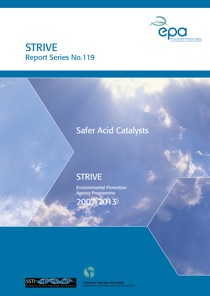STRIVE 119 - Safer Acid Catalysts
STRIVE 119 - Nick Gathergood
Summary: This report details our progress towards the development of safer, less toxic and biodegradable chemicals called acid catalysts.

Key points/ Findings
• The project successfully improved the activity of the acid catalysts, while maintaining excellent yields.
• The recommended final acid catalysts have low antimicrobial toxicity.
• In addition, green chemistry metrics to analyse the efficiency of the synthesis of the acid catalyst and waste generation were applied. By identifying the most environmentally damaging processes, and developing greener alternatives, we now have a cleaner synthesis of our recommended acid catalysts.
• A major challenge of the project was to prepare biodegradable acid catalysts. Predicting accurately biodegradation (i.e. computer modelling) of this class of compound (imidazolium salts) is not currently possible. This is in part due to the lack of experimental data to train modelling programmes. We successfully obtained biodegradation data for our imidazolium acid catalysts: however, none of these chemicals passed the CO2 Headspace Test.
• The impact of the work over the duration of the project has been stepwise.
• The project’s first publication reported catalyst performance only.
• The second combined performance and antimicrobial toxicity and was published in the leading Royal Society of Chemistry journal in the field, Green Chemistry in 2010.
• The latest dissemination is a series of three back-to-back papers in Green Chemistry, reporting catalyst performance, antimicrobial toxicity, biodegradation, green chemistry metrics and catalyst recycling. These papers are the triple front cover articles for the Green Chemistry 2013 October issue, with the first of the series also highlighted as a ‘Hot Article’ by reviewers.
• This justifies and validates the current research decision to our approach to jointly assess the toxicity, biodegradation, synthesis and performance of the catalysts at the development stage, which to the best of our knowledge, is unique to our Dublin City University (DCU)/Trinity College Dublin (TCD) team.
• When presenting our findings at conferences in Europe and the US, the overwhelming feedback is that this type of joint assessment should be the rule rather than the exception, and this is our key recommendation.
Recommendations
• Tandem catalyst performance and toxicity assessment has led to the development of a low antimicrobial toxicity and very active catalysts. This approach was successful and is advised for future studies;
• Boethlings’ ‘rules of thumb’ for designing biodegradable molecules should be modified to account for poor biodegradation of catalysts studied;
• The use of green chemistry metric assessment successfully highlighted parameters which can be targeted for further improvements in the reduction of waste for catalyst preparation.
Associated documentation can be viewed by following this link to our SAFER database
For Further Information
Dr Nick Gathergood , School of Chemistry, Dublin City University (DCU), Ireland.